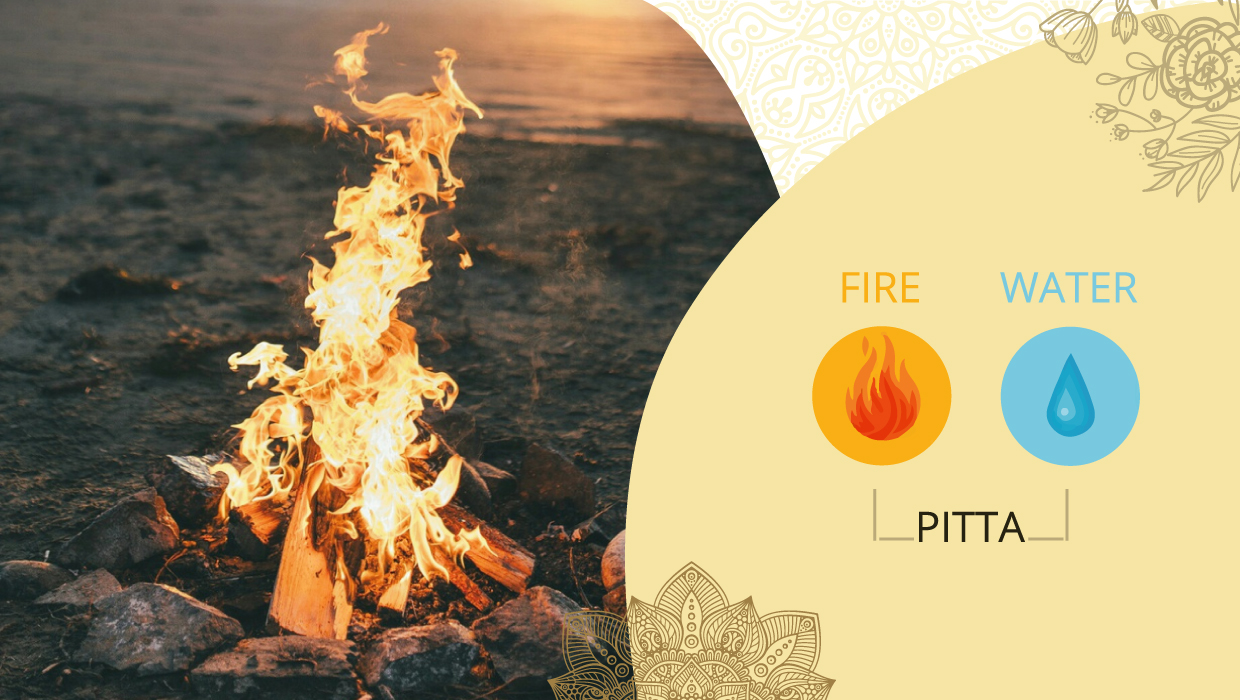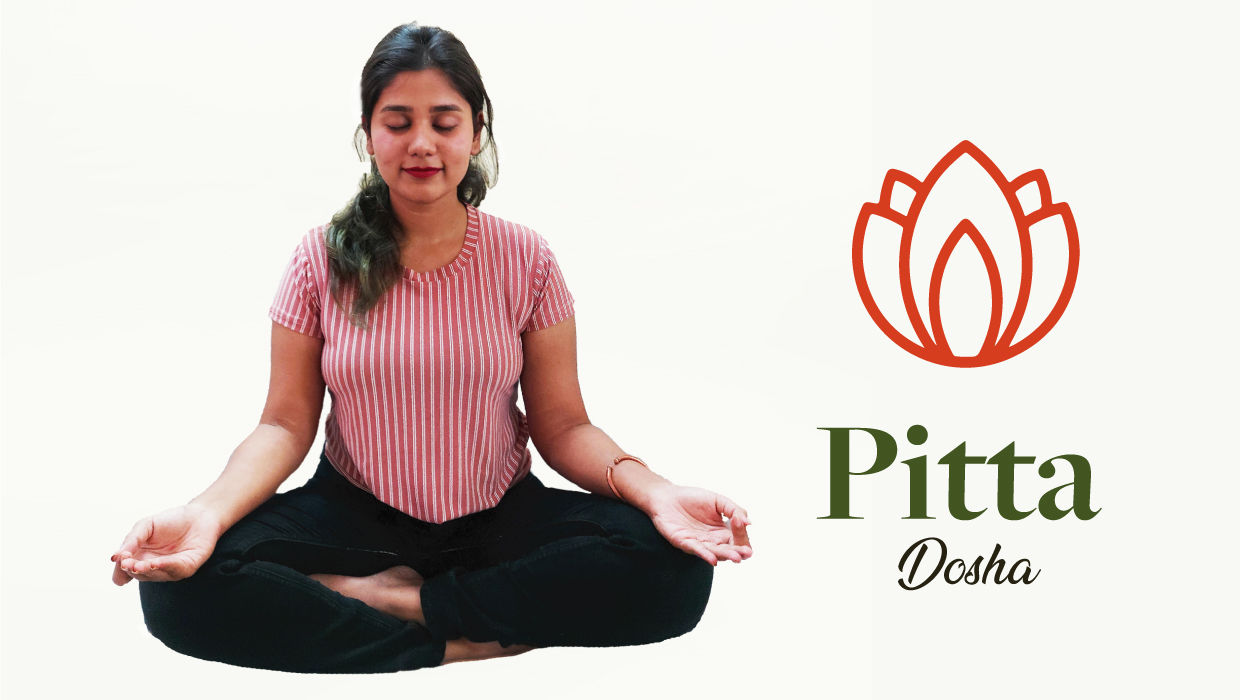Everything in the universe is composed of the five great elements- the Panchamahabhutas, namely, Fire, Water, Ether, Earth, and Air. These elements construct the macrocosm – the universe, as well as the microcosm – our inner worlds.
The Ayurvedic system analyzes the human body on the basis of the existence of these elements, and knowledge of the elements is essential to understand the interrelation of the mind, body, and spirit in the language of the Doshas.

Pitta Dosha, commonly translated into “that which digests, cooks and transforms”, is a combination of the Fire and Water elements.
It is characterized as being hot, sharp, mobile, penetrating, sour, and oily.
Its main functions include transformation, digestion, and metabolism. In the human body, it transforms food into Chyle – a fluid formed after digestion. The main location or seat of Pitta dosha is the stomach and small intestine.
People with a dominant Pitta dosha tend to be driven, fiery and ambitious.
Are you a Pitta Dominant? Let’s Find Out!
Physical Characteristics of Pitta Dosha
People with dominant Pitta doshas tend to be medium-shaped bodies with a muscular structure. They tend to have sharp angular features with defined jawlines. Their intense passion and ability to see through things are visible in their deep-set eyes. Pitta’s skin type is sensitive and majorly oily/combination. They tend to have smooth silky hair with hair fall as their major concern.
Due to the excess of fire in their body, they tend to have warm body temperature, good digestion, a strong appetite, and an abundance of energy.
Emotional Characteristics of Pitta Dosha
Pittas have a strong ability to concentrate and are considered to have a sharp and discerning intellect. Due to an overabundance of heat energy, they tend to be goal-driven and possess leadership qualities. They tend to be good decision-makers with amazing leadership qualities when the dosha is in balance. Whereas cranky, short-tempered, and easily triggered when out of balance.
When Pitta is disturbed, it expresses itself in the negative qualities of anger, aggression, and being judgemental.
It manifests with physical symptoms such as diarrhea, skin irritation, fever, inflammation, odorous sweating, and burning sensations, ulcers, and vision issues.
Let’s take a step to regain Balance!

Tips for Balancing Pitta Dosha
Excess Pitta tends to increase the level of heat and intensity in the system. On a daily routine, the individual should naturally introduce a calm, grounding energy that aids in disrupting the cycles of stress and busy-ness. As much as we may resist, a daily routine is vital for balancing Pitta.
Take the pressure off
Excess Pitta can cause a bit of an all-or-nothing mindset, fueled by a driving internal sense of ambition. It is important for individuals, to remind themselves to take some pressure off and not to take life too seriously. Instead, have the willingness to make mistakes and laugh about them. Bring space into the day to relax, to reduce any excess stress for better decision making.
Introduce play with productivity
It is important to create time to slow down, relax, and be playful. It is recommended to always leave space for some downtime every day, as much as possible. Permit yourself to take a step back from duty and to-do list work, and do something that makes you happy and playful. It will help you to get out of your head and tune in with your body.
The goal is to back off from effort and intensive work and be productive while being playful.
Rest is a priority
Where Pitta is concerned, prioritizing “rest” matters. It is recommended to consider committing to an early bedtime as a way of discouraging Pitta’s tendency to be productive late at night. Staying up late tends to be more disruptive than helpful for Pitta. A minimum of seven hours of sleep is recommended. In addition to a sleep schedule, allowing space for restoration throughout the whole day is vital, rejuvenating, and Pitta balancing. When Pitta is out of balance, it can lead to experiencing fiery hot emotions.
Giving space to relax throughout the day to soothe yourself is essential.
Take care of your skin
While skincare is usually a key factor in any daily routine, it is especially important when excess Pitta is present.
Pittas’ hot qualities can often express themselves through the skin as redness, inflammation, rashes, acne, or other irritations. It is essential to cool down the system by consuming cooling foods like Amla and Aloe vera or self-massage.
Move, but in an easy motion
When Pitta is high, we want to be mindful of how we engage in physical activity. Over-exercising, in an intense manner, can be Pitta aggravating. While exercising is vital, it is important not to overdo it. Physical exercise for Pitta people should be mostly in a way that protects the body against excess heat and intensity while cultivating a relaxed effort. The best forms of exercise for Pitta are those activities that have a moderate pace and are adequately challenging without pushing too hard on oneself. An approach to movement that is both fluid and grounding is the ultimate pace for Pitta people. Exercises include hiking, yoga, swimming, cycling, snowshoeing, and many more.
A Pitta Balancing Diet
Pitta is balanced by a diet of fresh, whole foods, both cooked and raw, which is energizing, dry, and rich in carbohydrates. These foods calm Pitta by decreasing the fire within, averting inflammation, balancing the Agni (the digestive fire), grounding the body, and reducing excess liquids. It is recommended for Pitta people to avoid oily, chilly, salty, and heavy foods such as fried food.
Recommended Pitta foods include:
- Fruits and vegetables: coconut, cranberries, apple, pomegranate, cucumber, asparagus, kale, broccoli, potatoes, peas, etc.
- Dairy and fats/oils: whole milk, unsalted cheese, ghee, sunflower oil, coconut oil, cottage cheese but in moderation, etc.
- Nuts, seeds, and legumes: lentils, chickpeas, peeled almonds, sunflower seeds, pecans, etc.
- Grains: basmati rice, quinoa, barley pasta, couscous, etc.
- Sweeteners: Honey but in moderation
- Beverages: mint tea, chamomile tea, rosehip tea, black tea with milk and honey, etc.
Pittas are highly goal-driven, planners and leaders when in a state of balance. So use the above tips very wisely and thoroughly to create a sense of balance and stability ever-active mind. Stay Cool, Stay Happy and Stay Balanced.
Join us to read more of such articles and support our mission of mindful living for the modern world by subscribing to our blog and hitting us a follow on Instagram and Facebook @sarvedalife.

